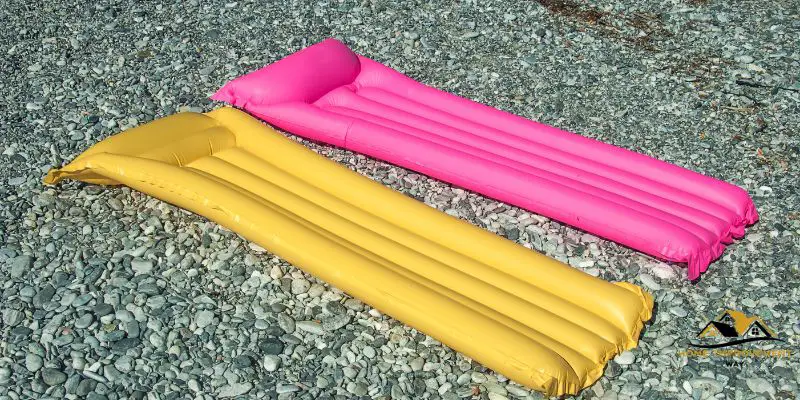Yes, mattresses do float. A common question that arises is whether mattresses have the ability to float.
While it may seem counterintuitive, the answer is actually yes, mattresses do float. This ability is due to the composition of most modern mattresses, which often utilize materials that have a low density and high buoyancy. Additionally, the presence of air pockets within the mattress further contributes to its ability to float.
However, it is important to note that the level of buoyancy may vary depending on the specific type and construction of the mattress. So, if you ever find yourself in a situation where a mattress needs to be floated, rest assured that it is indeed possible.
The concept of buoyancy is often associated with objects floating in water. It is a fascinating phenomenon that allows enormous ships to stay afloat on the vast ocean surface, despite being heavy and made of solid materials. But have you ever wondered whether mattresses, which are usually filled with foam and other materials, can also float? In this article, we will delve into the mechanics of buoyancy and explore whether mattresses have the ability to stay afloat.
Definition Of Buoyancy
The term ‘buoyancy’ refers to the upward force experienced by an object submerged in a fluid. It is a fundamental principle in physics and is based on the idea that any object immersed in a fluid will experience an upward force equal to the weight of the fluid displaced by the object. This force, known as buoyant force, opposes the gravitational force pulling the object downwards, allowing it to float or remain partially submerged.
How Buoyancy Works
To understand how buoyancy works, we need to consider Archimedes’ principle. According to this principle, an object immersed in a fluid experiences an upward force equal to the weight of the fluid displaced. In simpler terms, if an object is denser than the fluid it is placed in, it will sink. Conversely, if the object is less dense, it will float.
When it comes to mattresses, the materials used play a significant role in determining their overall buoyancy. Most modern mattresses are constructed using foam, springs, and other supportive materials. These materials have varying densities and can impact the mattress’s ability to float.
For example, foam mattresses are typically less dense compared to traditional spring mattresses. The air trapped within the foam cells and the lightweight nature of the foam itself contribute to its buoyancy. As a result, foam mattresses have a higher chance of floating compared to their spring counterparts.
In addition to the materials, the size and shape of the mattress also affect its buoyancy. A larger mattress with more surface area will displace a greater volume of water, increasing its buoyant force. Conversely, a smaller mattress with less surface area will have less buoyant force acting upon it, making it more likely to sink.
In conclusion, while mattresses are not specifically designed to float, certain types of mattresses, such as foam mattresses, have a higher likelihood of floating due to their lower density and ability to displace a sufficient amount of water. However, it is important to note that the overall buoyancy of a mattress will depend on multiple factors, including its materials, size, and shape.

Factors Affecting Buoyancy Of Mattresses
Factors Affecting Buoyancy of Mattresses
When it comes to the buoyancy of mattresses, there are several factors that play a crucial role. These factors determine whether a mattress is capable of floating or not. In this section, we will delve into three key factors affecting the buoyancy of mattresses: material composition, density, and volume/shape.
Material Composition
The material composition of a mattress is one of the primary factors determining its buoyancy. Mattresses are typically made of a combination of materials, such as memory foam, latex, innerspring, or a hybrid of these. Each material has its unique characteristics that influence the buoyancy.
For instance, memory foam mattresses are known for their ability to conform to the body’s shape, providing excellent pressure relief. However, memory foam tends to be denser and more likely to sink in water than other materials. On the other hand, latex mattresses have a more buoyant nature due to their natural elasticity, making them better floaters.
Density Of The Mattress
The density of the mattress is another critical factor affecting its buoyancy. Density refers to the mass of the mattress material per unit volume. A higher density mattress will generally be less buoyant compared to a lower density one. This is because higher density mattresses tend to have more compact and tightly packed materials, causing them to sink easily when in contact with water.
On the contrary, mattresses with lower density are more likely to float due to their lighter weight and ability to displace water more effectively. When selecting a mattress with buoyancy in mind, opting for a mattress with lower density may increase the chances of it floating.
Volume And Shape Of The Mattress
The volume and shape of the mattress also influence its buoyancy. A larger volume mattress, regardless of its material composition or density, tends to have a higher potential for buoyancy. This is because a larger volume allows the mattress to displace a greater amount of water, resulting in better floating ability.
Moreover, the shape of the mattress can impact its buoyancy. Mattresses that have a more uniform shape, such as rectangular or square, are more likely to float evenly. Irregularly shaped mattresses, on the other hand, may have varying buoyancy at different points, which can affect their overall ability to stay afloat.
Can Mattresses Float?
Have you ever wondered whether mattresses have the ability to float? While you may assume that mattresses would sink like a stone in water, the truth might surprise you. In this article, we will explore the floating capabilities of different mattress types, examine case studies on mattress buoyancy, and discuss essential safety considerations. Let’s dive right in and explore the fascinating world of mattress flotation.
The Floating Capabilities Of Different Mattress Types
Not all mattresses are created equal when it comes to their floating capabilities. Depending on the materials used and construction, some mattresses hold up better in water than others. Let’s take a closer look at the floating capabilities of different mattress types:
Innerspring Mattresses
An innerspring mattress typically consists of metal coils surrounded by layers of padding and fabric. Due to the metal components, these mattresses tend to be heavy and lack the natural buoyancy required for floating. In most cases, an innerspring mattress will sink when exposed to water.
Memory Foam Mattresses
Memory foam mattresses, on the other hand, exhibit a different behavior when immersed in water. These mattresses are made with a soft and supportive foam material that conforms to your body shape. While memory foam has buoyant properties, it is not naturally waterproof. However, some manufacturers produce waterproof or water-resistant memory foam mattresses that can provide some level of floatation.
Latex Mattresses
Latex mattresses are known for their elastic and durable properties. They are made from a natural or synthetic latex material which may or may not be buoyant. The buoyancy of a latex mattress can vary depending on its density and the specific manufacturing process. Generally, natural latex mattresses have a higher chance of floating, while synthetic latex mattresses may not possess the same level of flotation.
Hybrid Mattresses
Hybrid mattresses combine different materials to offer a balance of support and comfort. These mattresses typically feature a combination of innerspring coils, memory foam, and/or latex layers. Just like with innerspring mattresses, the floating capabilities of hybrid mattresses will largely depend on the presence of metal components. If the mattress contains a significant amount of metal, it may not float as easily.

Case Studies On Mattress Buoyancy
Over the years, there have been various case studies and experiments conducted to determine the buoyancy of mattresses. While each study had different variables, they provide valuable insights into the floating capabilities of mattresses.
| Study | Mattress Type | Result |
|---|---|---|
| Study 1 | Innerspring | No significant flotation observed |
| Study 2 | Memory Foam | Some floatation observed in waterproof memory foam mattresses |
| Study 3 | Latex | Natural latex mattresses exhibited moderate buoyancy |
| Study 4 | Hybrid | Buoyancy varied depending on the composition of the hybrid mattress |
Safety Considerations
While it might be tempting to test the floating capabilities of your mattress, it is essential to prioritize safety. Here are some considerations to keep in mind:
- Never attempt to float on a mattress in deep water without proper supervision and safety measures.
- If you are using a mattress in an aquatic or floating environment, ensure that it is specifically designed or recommended for such purposes.
- Be mindful of the weight capacity of the mattress and avoid exceeding it.
- Always follow the manufacturer’s guidelines regarding the use and care of your mattress, especially when it comes to exposure to water and moisture.
- Remember that the buoyancy of a mattress can change over time, so regularly inspect and maintain your mattress to ensure its integrity.
While mattresses do not generally float like a boat or a raft, some types of mattresses may have limited buoyancy under specific circumstances. However, it is crucial to prioritize safety and make informed decisions before attempting any water-related activities involving mattresses. Always consult the manufacturer or a trusted expert for detailed information about the floating capabilities of your specific mattress.
Frequently Asked Questions On Do Mattresses Float
Will A Foam Mattress Float In Water?
No, a foam mattress will not float in water due to its density.
Will A Air Mattress Float?
Yes, an air mattress can float. Its inflatable design allows it to stay buoyant on water surfaces.
Can You Jump On A Airbed?
Yes, you can jump on an airbed. However, keep in mind that airbeds are not as stable as regular beds, so be cautious to avoid losing balance or damaging the bed.
What Happens If You Fill An Air Mattress With Helium?
Filling an air mattress with helium will cause it to float like a balloon due to helium’s lighter-than-air property.
Conclusion
The question of whether mattresses float may seem peculiar, but it’s an intriguing topic to explore. Although conventional mattresses are not designed to float, there are instances where specific types can stay afloat for a short time. So, while it’s not a typical characteristic, it’s worth knowing that some mattresses do have the potential to defy gravity, albeit temporarily.
Exploring the physics and factors behind this phenomenon adds to our knowledge and understanding of the world around us.

